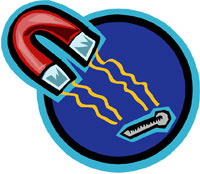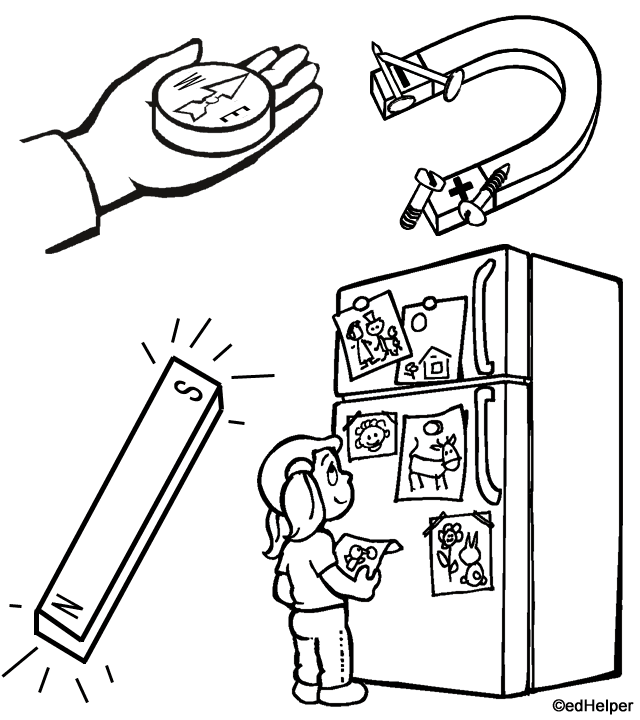Magnetism 4th Grade VSC Content Indicators and Objectives |
Cite evidence supporting that forces can act on objects without touching them. · Investigate and describe the effect that two magnets have on each other. Like poles repel Opposite poles attract · Based on observations, describe the effect of a magnet on a variety of objects including those that are metallic or non-metallic; those made with iron or made with other metals; and on other magnets. · Compare a compass to a magnet based on observations of the effect a variety of objects (metallic or non-metallic; those made with iron or other metals; and magnets) have on a compass. · Provide examples to demonstrate the different ways a magnet acts on objects and how the objects respond. · Describe how to make a simple electromagnet with a battery, a nail, and wire. |
VSC Skill and Processes Indicators |
Gather and question data from many different forms of scientific investigations which include reviewing appropriate print resources, observing what things are like or what is happening somewhere, collecting specimens for analysis, and doing experiments. · Support investigative findings with data found in books, articles, and databases, and identify the sources used and expect others to do the same. · Explain that comparisons of data might not be fair because some conditions are not kept the same. · Recognize that the results of scientific investigations are seldom exactly the same, and when the differences are large, it is important to try to figure out why. · Follow directions carefully and keep accurate records of one's work in order to compare data gathered. Identify possible reasons for differences in results from investigations including unexpected differences in the methods used or in the circumstances in which the investigation is carried out, and sometimes just because of uncertainties in observations. · Develop explanations using knowledge possessed and evidence from observations, reliable print resources, and investigations. · Offer reasons for their findings and consider reasons suggested by others. · Review different explanations for the same set of observations and make more observations to resolve the differences. · Recognize that clear communication is an essential part of doing science because it enables scientists to inform others about their work, expose their ideas to criticism by other scientists, and stay informed about scientific discoveries around the world. |
Magnetism
Electromagnet
Compass
Poles
Force
Repel
Attract
Metals
PRE-TEST Magnets
|
| ||||
|
| ||||
|
|
|
|
| Magnets By Jane Runyon |  |
 1 Mrs. Kim's class was ready for Science class. Mrs. Kim put a desk at the front of the class. There was a cloth over the top of the desk. She asked the class to pay close attention. She told them she was going to take the cloth off the desk. When she did, there would be objects on the desk top. She wanted the class to look at each object.
1 Mrs. Kim's class was ready for Science class. Mrs. Kim put a desk at the front of the class. There was a cloth over the top of the desk. She asked the class to pay close attention. She told them she was going to take the cloth off the desk. When she did, there would be objects on the desk top. She wanted the class to look at each object.2 "After you have looked at the objects," she said, "I want someone to describe what each object looks like."
3 The children looked at the objects. "Are you ready?" asked Mrs. Kim.
4 The children nodded their heads to say yes. Mrs. Kim picked up one of the objects. "Who would like to describe this?" she asked.
5 Matthew stood beside his desk. "The object you have is curved like a horseshoe," he said. "It has red paint on one end and yellow paint on the other end. It looks like it is made of a hard material."
6 "Thank you, Matthew," said Mrs. Kim picking up the second object. "Who would like to describe this?"
7 Laura stood up. "That object is about as long as my pointer finger," she said. "It is flat. It also looks like it is made from a hard material."
8 "Thank you, Laura," Mrs. Kim said. "And this object?"
9 Michael stood up. "That object is round. It has a hole in the center. It is flat, also. It looks like it is made of steel."
10 "Very good, all of you," said Mrs. Kim. "How are these objects alike?"
11 C. J. raised his hand. "Yes, C. J.," said Mrs. Kim.
12 "They are all made of something hard," he said.
13 "That is true," answered Mrs. Kim. "Is there anything else?"
14 The members of the class thought about the question. None of them could think of anything else. Then Mrs. Kim picked up a paper clip. She held the paper clip above the horseshoe shaped object. The object seemed to pull the paper clip right out of her hand. The same thing happened when she held the paper clip over the long flat object. It happened a third time with the round object.
Assignment=Please copy this graphic organizer into your journal and complete it from the reading above.
15 "They're all magnets!" shouted several children at once.
16 "How did you know that?" asked Mrs. Kim.
17 "A magnet attracts metal things," answered Maddie.
18 "What if I put a pencil above each object?" asked Mrs. Kim.
19 "Nothing would happen," answered Maddie. "A pencil is made of wood."
20 "What else do you know about magnets?" asked Mrs. Kim.
21 "I read a book about magnets," said Luke. "Each magnet has a north pole and a south pole. Even if you broke a magnet into two pieces, each piece would have a north pole and a south pole."
22 "What if I put the north pole of one magnet next to the south pole of another magnet?" the teacher asked.
23 "The two ends will stick together," answered Luke. "They are attracted to each other."
24 "And what if I put the north pole of one magnet next to the north pole of another magnet?" Mrs. Kim continued.
25 Luke knew that answer, also. "The two ends would push each other away. They repel each other."
Assignment=Please copy this graphic organizer into your journal and complete it from the reading above.
26 Mrs. Kim picked up the horseshoe magnet and the long, flat magnet. "It is easy to see that these magnets have two ends," she said. "One would be the north pole and one would be the south pole. I can put north to south and they stick together. I can put north to north and they push apart. But what about the round magnet? It has no ends."
27 The children thought about that for awhile and shared their ideas with each other. Then Mrs. Kim said, "We're going to answer our question the scientific way. We are going to experiment."
28 "Oh, boy," said Peter, "I love to do experiments."
29 "I want you each to get a partner," Mrs. Kim continued. "One of the partners needs to go to the art shelf and get a piece of clay about the size of a walnut."
30 The children paired up and got their clay.
31 "I would like for you to make the clay into a ball and stick it onto the top of a desk. When you have that done, please take a new pencil out of the pencil box. Stand the pencil up in the clay."
32 The children followed their teacher's instructions.
33 "I am now going to put two round magnets on each desk. I would like for you to slip one round magnet onto the pencil. Put the pencil through the center hole. Now put the second magnet onto the pencil in just the same way."
34 Some of the children said "Oh, wow!" Some of the children didn't. What do you think happened to the magnets? Try this experiment yourself. If you don't say "Oh, wow!" what could you do to change the experiment?
26 Mrs. Kim picked up the horseshoe magnet and the long, flat magnet. "It is easy to see that these magnets have two ends," she said. "One would be the north pole and one would be the south pole. I can put north to south and they stick together. I can put north to north and they push apart. But what about the round magnet? It has no ends."
27 The children thought about that for awhile and shared their ideas with each other. Then Mrs. Kim said, "We're going to answer our question the scientific way. We are going to experiment."
28 "Oh, boy," said Peter, "I love to do experiments."
29 "I want you each to get a partner," Mrs. Kim continued. "One of the partners needs to go to the art shelf and get a piece of clay about the size of a walnut."
30 The children paired up and got their clay.
31 "I would like for you to make the clay into a ball and stick it onto the top of a desk. When you have that done, please take a new pencil out of the pencil box. Stand the pencil up in the clay."
32 The children followed their teacher's instructions.
33 "I am now going to put two round magnets on each desk. I would like for you to slip one round magnet onto the pencil. Put the pencil through the center hole. Now put the second magnet onto the pencil in just the same way."
34 Some of the children said "Oh, wow!" Some of the children didn't. What do you think happened to the magnets? Try this experiment yourself. If you don't say "Oh, wow!" what could you do to change the experiment?
Assignment=Please copy this graphic organizer into your journal and complete it from the reading above.
Copyright © 2011 edHelper
Copyright © 2011 edHelper
 |
|
| ||||
|
| ||||
|
|
Magnets
|
|
 |
Magnets
Magnets
Assignment=Please copy this graphic organizer into your journal and complete it from the reading above.
| Magnets By Jane Runyon |  |
Directions: Fill in each blank with the word that best completes the reading comprehension.
 Mrs. Kim's class was ready for Science class. Mrs. Kim put a desk at the front of the class. There was a cloth over the top of the desk. She asked the class to pay (1) _______________________ (2) _______________________ . She told them she was going to take the cloth off the desk. When she did, there would be objects on the desk top. She wanted the (3) _______________________ to look at each object.
Mrs. Kim's class was ready for Science class. Mrs. Kim put a desk at the front of the class. There was a cloth over the top of the desk. She asked the class to pay (1) _______________________ (2) _______________________ . She told them she was going to take the cloth off the desk. When she did, there would be objects on the desk top. She wanted the (3) _______________________ to look at each object."After you have looked at the objects," she said, "I want someone to describe what each object looks like."
The children looked at the objects. "Are you (4) _______________________ ?" asked Mrs. Kim.
The children nodded their heads to say yes. Mrs. Kim picked up one of the objects. "Who would like to describe this?" she asked.
Matthew stood beside his desk. "The object you have is curved like a horseshoe," he said. "It has red paint on one end and yellow paint on the other end. It looks like it is made of a hard material."
"Thank you, Matthew," said Mrs. Kim (5) _______________________ up the second object. "Who would like to describe this?"
Laura stood up. "That object is about as long as my pointer finger," she said. "It is flat. It also looks like it is made from a hard(6) _______________________ ."
"Thank you, Laura," Mrs. Kim said. "And this object?"
Michael stood up. "That object is round. It has a hole in the center. It is (7) _______________________ , also. It looks like it is made of steel."
"Very good, all of you," said Mrs. Kim. "How are these objects (8) _______________________ ?"
C. J. raised his hand. "Yes, C. J.," said Mrs. Kim.
"They are all made of something hard," he said.
"That is (9) _______________________ ," answered Mrs. Kim. "Is there anything else?"
The members of the class thought about the question. None of them could think of anything else. Then Mrs. Kim picked up a paper clip. She held the paper clip above the horseshoe shaped object. The object seemed to pull the paper clip right out of her hand. The(10) _______________________ thing happened when she held the paper clip over the long flat object. It happened a(11) _______________________ time with the round object.
"They're all magnets!" shouted several children at once.
"How did you know that?" asked Mrs. Kim.
"A magnet attracts metal things," answered Maddie.
"What if I put a pencil above each object?" asked Mrs. Kim.
"Nothing would happen," answered Maddie. "A pencil is made of wood."
"What else do you know about magnets?" asked Mrs. Kim.
"I read a book about magnets," said Luke. "Each magnet has a north pole and a south pole. Even if you broke a magnet into two pieces, each piece would have a north pole and a (12) _______________________ pole."
"What if I put the north pole of one magnet next to the south pole of another magnet?" the teacher asked.
"The two ends will stick together," answered Luke. "They are attracted to each other."
"And what if I put the north pole of one magnet next to the north pole of another magnet?" Mrs. Kim continued.
Luke knew that answer, also. "The two ends would push each other away. They repel each other."
Mrs. Kim picked up the horseshoe magnet and the long, flat magnet. "It is (13) _______________________ to see that these magnets have two ends," she said. "One would be the north pole and one would be the south pole. I can put north to south and they stick together. I can put north to north and they push apart. But what about the round magnet? It has no ends."
The children thought about that for awhile and shared their ideas with each other. Then Mrs. Kim said, "We're going to answer our question the scientific way. We are going to experiment."
"Oh, boy," said Peter, "I love to do experiments."
"I want you each to get a (14) _______________________ ," Mrs. Kim continued. "One of the(15) _______________________ needs to go to the art shelf and get a piece of clay about the size of a walnut."
The children paired up and got their clay.
"I would like for you to make the clay into a ball and stick it onto the top of a desk. When you have that done, please take a new pencil out of the pencil box. Stand the pencil up in the clay."
The children followed their teacher's instructions.
"I am now going to put two round magnets on each desk. I would like for you to slip one round magnet onto the pencil. Put the pencil through the center hole. Now put the second magnet onto the pencil in just the same way."
Some of the children said "Oh, wow!" Some of the children didn't. What do you think happened to the magnets? Try this experiment yourself. If you don't say "Oh, wow!" what could you do to (16) _______________________ the experiment?
Copyright © 2011 edHelper
Magnets
|
| ||||
|
| ||||
|
|
|
|
Vocabulary | Conceptual Understandings |
Magnets Magnetism Electromagnet Compass Poles Force Repel Attract Metals | · Magnetism is a force. Magnetic force acts upon many metals · Magnets may be natural or man-made. The Earth is a giant magnet |
Lessons | |
1. Magnets interact with different metals 2. Magnets interactions with other magnets (variety of types) 3. Magnetic force lines 4. Natural magnets/Man-made magnets (electromagnet) 5. Earth as a magnet |


No comments:
Post a Comment